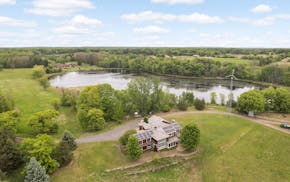The price of a massive Xcel Energy transmission line across southwest and central Minnesota — which would connect more wind and solar farms — has more than doubled to $1.14 billion.
The higher price tag reflects inflation and supply chain issues, plus other factors such as a longer route — and, if approved by the Minnesota Public Utilities Commission, costs would be passed on to customers.
The Xcel line is not the only one facing cost increases. Minnesota Power's plan to upgrade a 465-mile transmission line running from North Dakota to northeastern Minnesota was estimated early in 2022 to cost $700 million. Now, the Duluth-based company says it will cost between $800 million and $940 million.
Spokeswoman Amy Rutledge said since 2022 there has been a "worldwide surge" in high-voltage-direct-current system orders "directly competing with Minnesota Power for limited manufacturing slots."
Rutledge said a competitive market and high inflation for basic components of the project are also to blame.
The earlier estimate of $528 million for the Xcel line came from a plan approved by Minnesota regulators in 2022 but drafted in 2019, company spokesman Kevin Coss said.
The original plan called for the Xcel-owned Minnesota Energy Connection line to be 140 miles long. The proposed route is now about 175 miles. Plus, along the way, Xcel found needs such as additional substations to provide system reliability, Coss said.
The route will stretch from near the city of Garvin in Lyon County to Becker in central Minnesota. It's meant to connect wind and solar farms in southern Minnesota and would use Xcel's existing interconnections at the large Sherco power complex in Becker.
The first of Sherco's three coal-fired generators isexpected to start shutting down toward the end of this year, shifting Xcel's power breakdown to lean more heavily on clean energy. The utility also plans to build a massive solar farm on the Becker site.
The Lyon County-to-Becker line is expected to be running by the fall of 2027, though Xcel must be granted state and federal permits first.
"The Minnesota Energy Connection transmission line stands to help us take a major step toward a carbon-free electricity future, allowing us to connect 4,000 megawatts of new low-cost wind and solar energy to the grid while keeping our systems reliable," Coss said.
Beth Soholt, executive director of the St. Paul-based nonprofit Clean Grid Alliance, said costs for both transmission and energy generation projects have increased "pretty significantly."
Soholt said demand is high because so many utilities and developers are trying to build projects. The cost of raw materials like steel is up, and the same with labor. A long permitting process can add costs, too.
"There's like an 18-month backlog in transformers," Soholt said. "It is a universal problem, no part of the country is immune from it."
The line is one of several new transmission projects proposed in Minnesota as the state and region push to ease congestion on the power grid and make space for alternative sources amid the shift away from fossil fuels.
In July, the operator of the regional power grid, the Midcontinent System Operator (MISO), approved $10.3 billion for new transmission projects across the Midwest. MISO is planning to propose another set of projects soon. The nonprofit plans power lines but assigns them to utilities like Xcel to seek permits, build and operate the lines.

Minnesota Department of Health rescinds health worker layoffs

Eco-friendly house on 30 acres near Marine on St. Croix listed at $1.6M

DOGE cuts federal money for upgrades at Velveeta plant in New Ulm

